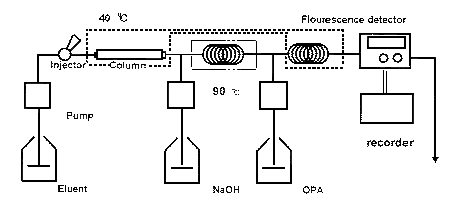Analysis Method of N-methyl Carbamates
N-methylcarbamates are widely used as insecticides for agricultural products.
Their residual concentration in such products must be monitored in order to keep
our health and to avoid environmental pollution.
EPM method which uses HPLC is the well-known method. In Japan, Notification No.199
of Japanese Ministry of Health and Welfare for the detection of N-methylcarbamates
by HPLC was determined in 1994. According to these methods, N-methylcarbamates
are separated by an ODS column using a gradient elution system and is followed
by a postcolumn base hydrosis that liberates methylamine, which further reacts
with o-phthalaldehyde (OPA)-mercaptoethanol to form a highly fluorescent isoindole.
This is a very sensitive the method. However, the method must be performed under
gradient elution conditions, and requires additional time and equipment. RSpak
CARB-413, which is packed with a polymethacrylate polymer gel
realized the simple and rapid analysis of N-methylcarbamates because it can
analyze N-methylcarbamates with isocratic elution without using gradient
elution. The following is the system to be used for the analysis of
N-methylcarbamates.

The following is the analysis conditions:
Column : RSpak CARB-413 (4.6mmID*150mm)
Eluent : 37% Aetonitrile in distilled water
Flow rate : 0.8mL/min
Hydrolysis reagent : 0.05M NaOH
Reaction temp. : 90deg-C
Reaction time : 0.1min
Flow rate : 0.4mL/min
Derivertive reagent : 0.05% o-phthalaldehyde, 0.1% mercaptoethanol
Reaction temp. : 40deg-C
Flow rate : 0.4mL/min
Detector : Fluorescence detector (Ex.340nm, Em.450nm)
(Ex.319nm, Em.392nm for pirimicarb)
Sample volume : 20micro-L
